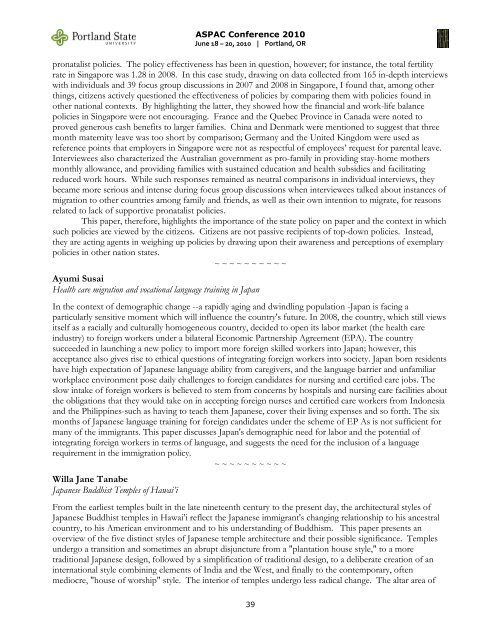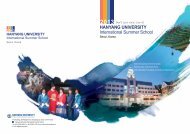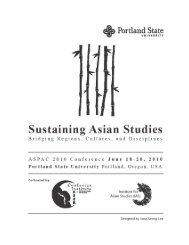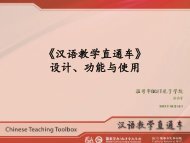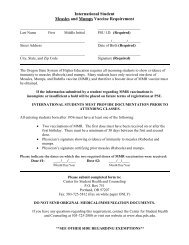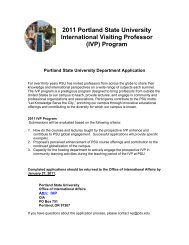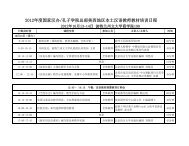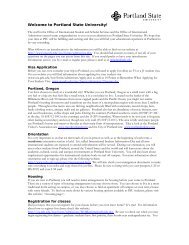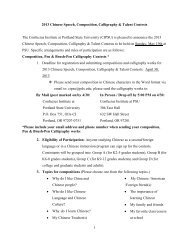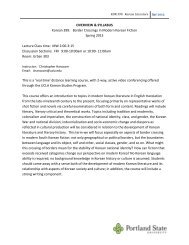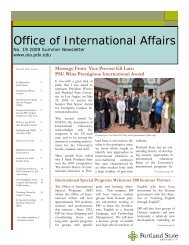ABSTRACTS - oia - Portland State University
ABSTRACTS - oia - Portland State University
ABSTRACTS - oia - Portland State University
You also want an ePaper? Increase the reach of your titles
YUMPU automatically turns print PDFs into web optimized ePapers that Google loves.
ASPAC Conference 2010<br />
June 18 – 20, 2010 | <strong>Portland</strong>, OR<br />
pronatalist policies. The policy effectiveness has been in question, however; for instance, the total fertility<br />
rate in Singapore was 1.28 in 2008. In this case study, drawing on data collected from 165 in-depth interviews<br />
with individuals and 39 focus group discussions in 2007 and 2008 in Singapore, I found that, among other<br />
things, citizens actively questioned the effectiveness of policies by comparing them with policies found in<br />
other national contexts. By highlighting the latter, they showed how the financial and work-life balance<br />
policies in Singapore were not encouraging. France and the Quebec Province in Canada were noted to<br />
proved generous cash benefits to larger families. China and Denmark were mentioned to suggest that three<br />
month maternity leave was too short by comparison; Germany and the United Kingdom were used as<br />
reference points that employers in Singapore were not as respectful of employees’ request for parental leave.<br />
Interviewees also characterized the Australian government as pro-family in providing stay-home mothers<br />
monthly allowance, and providing families with sustained education and health subsidies and facilitating<br />
reduced work hours. While such responses remained as neutral comparisons in individual interviews, they<br />
became more serious and intense during focus group discussions when interviewees talked about instances of<br />
migration to other countries among family and friends, as well as their own intention to migrate, for reasons<br />
related to lack of supportive pronatalist policies.<br />
This paper, therefore, highlights the importance of the state policy on paper and the context in which<br />
such policies are viewed by the citizens. Citizens are not passive recipients of top-down policies. Instead,<br />
they are acting agents in weighing up policies by drawing upon their awareness and perceptions of exemplary<br />
policies in other nation states.<br />
~ ~ ~ ~ ~ ~ ~ ~ ~ ~<br />
Ayumi Susai<br />
Health care migration and vocational language training in Japan<br />
In the context of demographic change --a rapidly aging and dwindling population -Japan is facing a<br />
particularly sensitive moment which will influence the country's future. In 2008, the country, which still views<br />
itself as a racially and culturally homogeneous country, decided to open its labor market (the health care<br />
industry) to foreign workers under a bilateral Economic Partnership Agreement (EPA). The country<br />
succeeded in launching a new policy to import more foreign skilled workers into Japan; however, this<br />
acceptance also gives rise to ethical questions of integrating foreign workers into society. Japan born residents<br />
have high expectation of Japanese language ability from caregivers, and the language barrier and unfamiliar<br />
workplace environment pose daily challenges to foreign candidates for nursing and certified care jobs. The<br />
slow intake of foreign workers is believed to stem from concerns by hospitals and nursing care facilities about<br />
the obligations that they would take on in accepting foreign nurses and certified care workers from Indonesia<br />
and the Philippines-such as having to teach them Japanese, cover their living expenses and so forth. The six<br />
months of Japanese language training for foreign candidates under the scheme of EP As is not sufficient for<br />
many of the immigrants. This paper discusses Japan's demographic need for labor and the potential of<br />
integrating foreign workers in terms of language, and suggests the need for the inclusion of a language<br />
requirement in the immigration policy.<br />
~ ~ ~ ~ ~ ~ ~ ~ ~ ~<br />
Willa Jane Tanabe<br />
Japanese Buddhist Temples of Hawai’i<br />
From the earliest temples built in the late nineteenth century to the present day, the architectural styles of<br />
Japanese Buddhist temples in Hawai’i reflect the Japanese immigrant's changing relationship to his ancestral<br />
country, to his American environment and to his understanding of Buddhism. This paper presents an<br />
overview of the five distinct styles of Japanese temple architecture and their possible significance. Temples<br />
undergo a transition and sometimes an abrupt disjuncture from a "plantation house style," to a more<br />
traditional Japanese design, followed by a simplification of traditional design, to a deliberate creation of an<br />
international style combining elements of India and the West, and finally to the contemporary, often<br />
mediocre, "house of worship" style. The interior of temples undergo less radical change. The altar area of<br />
39


